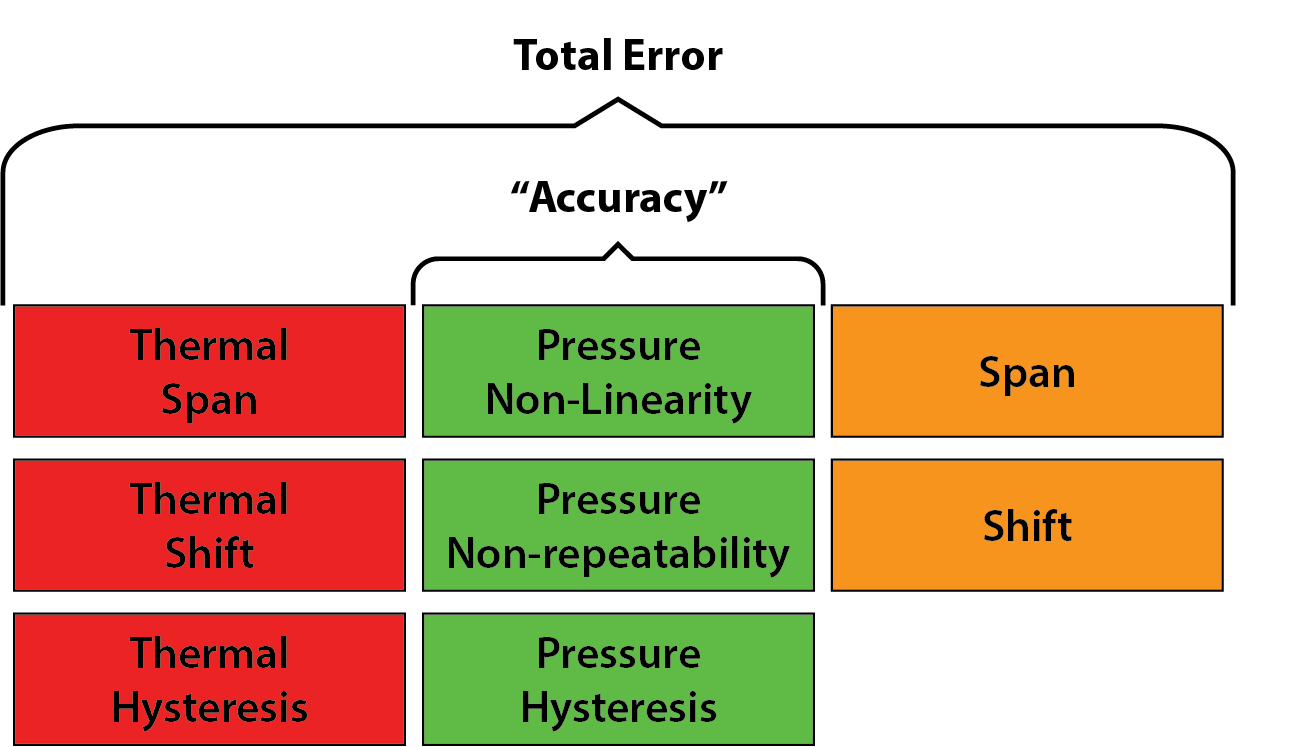| |
Don't be misled by Pressure Accuracy Specs
What is Accuracy?
Accuracy is an imprecise term for what it describes in the dry pressure industry. Yes, you read that correctly. First, it is really an estimate of inaccuracies but, that aside, it also doesn't paint a full picture. Accuracy is only a small portion of the true measurement capability of a sensor. The below image shows all of the possible types of error as well as the portion we typically call "accuracy."

The portion we call accuracy (green) is what you typically see on a specification. You may also see best-fit-straight-line (or BFSL) which is the non-linearity element of accuracy. These three elements are fairly straightforward and available in most specs so that we won't delve too far into them.
The (Often) Ignored Sources of Error
You can see from the above image that accuracy ignores span and shift (orange) and thermal effects (red).
-
Span tells you the entire range of the measurement. For example, a 0.5% span means a full scale pressure measurement may correspond to 0-9.95V output, instead of the expected 0-10V. This may be affected by calibration or drift effects.
-
Shift/Offset tells you if the measurement curve is shifted up, down, left, or right. For example, a 0.5% shift means a full scale pressure measurement may correspond to 0.05-10.05V. This may be affected by calibration, position sensitivity of a sensor or drift effects.
-
Thermal effects are due to variation in ambient temperature as well as heating that may be attributed to internal circuitry. Thermal effects also include span and shift, as well as hysteresis.
-
Hysteresis means the difference in the sensor's ability to measure a point on the curve if approached from above the point versus below the point. For example, a diaphragm sensing element may hold pressure for an instant when decreasing, causing a small lag in the sensor's ability to measure a decreasing pressure.
What to look for
Span and shift: Look out for unclear ±% error additions. Ask for calibration data for each unit instead of accepting additional error.
For analog devices, a known value for span and shift can be programmed fairly easily into the receiving controller and, therefore, should not contribute to any additional error in a device. This is why it's not typically included in the accuracy calculation. However, these values are usually listed as a +/- percentage and can be found amongst the small print at the bottom of a spec, which makes fine-tuning difficult and possibly inaccurate on the controller's end. The most precise way to account for span and shift error is to know the exact values for each device.
Thermal effects: Look out for any thermal shift over 0.02% FSO/oF.
Errors due to thermal effects are not as easily avoided, especially if your sensor is mounted in a duct or a mechanical room that is not at room temperature. Thermal effects are typically stated as %FSO/degree, so even a fractional value will significantly change the expected total full-scale accuracy (%FSO) as you deviate from room temperature.
For example, you may see a spec of +/-0.067%FSO/oF relative to 71oF. If this device is in a duct or room at 65oF, your 0.25% listed accuracy now looks more like 0.65%. A value below 0.02%FSO/oF will ensure you can be above or below room temp by 10oF and still be at or below 0.5% total accuracy. But remember, lower is always better.
Finally, beware of the fine print.
If a specification requires a lot of exceptions, make sure you read and understand all of them. Changing the mounting position or electrical load may reduce total accuracy if not considered.
Senva Makes it Simple.
Span and shift: We provide a NIST traceable calibration curve (line) for every precision sensor. No guesswork necessary.

Thermal effects: We calibrate every sensor at room temperature as well as at 60 °C (140°F) to account for those pesky thermal effects. Additionally, our P4 element utilizes a thermal compensation algorithm to eliminate thermal errors virtually.
Small Print: Our sensors are non-position sensitive and have very few "exceptions" to our claimed accuracy.
With senva's P4 Precision, you can measure with confidence.
|
|